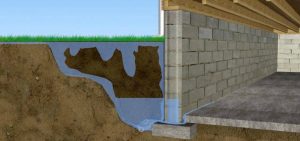A wet and damp basement can be a homeowner’s worst nightmare. Not only does it create an uncomfortable living environment, but it can also lead to costly structural damage and health concerns due to mold and mildew growth. Fortunately, there are several effective methods to waterproof your basement and keep it dry and safe. In this article, we will explore five of the best methods to waterproof a basement and protect your home investment.
Exterior Waterproofing
One of the most comprehensive ways to waterproof a basement is through exterior waterproofing. This method involves excavating the soil around the foundation of your home to access the exterior walls. Once exposed, the walls are cleaned, repaired, and sealed with a waterproof membrane or coating. Here’s a breakdown of the steps involved in exterior waterproofing:
Excavation: A trench is dug around the perimeter of the house, exposing the foundation walls.
Cleaning and Repair: Any cracks or imperfections in the foundation are repaired to ensure a solid surface.
Waterproof Membrane: A waterproof membrane or coating is applied to the exterior walls, providing a barrier against water penetration.
Drainage System: A drainage system, such as a French drain, is installed to direct water away from the foundation.
Backfilling: The trench is backfilled with gravel to promote proper drainage.
Exterior waterproofing is a highly effective method that prevents water from reaching the basement walls in the first place. While it can be more expensive and labor-intensive compared to other methods, it provides long-lasting protection and peace of mind.
Interior Waterproofing
Interior waterproofing is another popular method to keep your basement dry. Unlike exterior waterproofing, this method focuses on managing water that has already entered the basement. Here’s how interior waterproofing works:
Interior Drainage System: A perimeter drainage system is installed along the inside of the basement walls. This system includes a sump pump to collect and pump out excess water.
Vapor Barrier: A vapor barrier, such as a waterproof paint or epoxy coating, is applied to the interior walls to prevent moisture from entering.
Dehumidifiers: Dehumidifiers are used to maintain optimal humidity levels in the basement, reducing the risk of mold and mildew growth.
Crack Repair: Any existing cracks or leaks in the basement walls or floor are sealed to prevent further water intrusion.
Interior waterproofing is a cost-effective solution that can be implemented without excavating the exterior of your home. While it doesn’t provide the same level of protection as exterior waterproofing, it can effectively manage moisture issues in your basement.
Sealants and Waterproofing Paint
Sealants and waterproofing paints are a quick and affordable way to address minor moisture problems in your basement. These products create a protective barrier on the interior walls, preventing water from seeping through. Here are the key points to consider:
Sealant Application: Clean the basement walls thoroughly and apply a waterproof sealant or paint according to the manufacturer’s instructions.
Multiple Coats: Multiple coats may be necessary for maximum effectiveness.
Regular Maintenance: Periodically check the condition of the sealant or paint and reapply as needed.
Sealants and waterproofing paints are best suited for basement walls with minor seepage issues. While they may not provide a long-term solution for significant water intrusion, they can be a valuable part of your overall waterproofing strategy.
Exterior Drainage Solutions
Another effective way to prevent basement water issues is by managing the flow of water around your home’s exterior. Proper exterior drainage solutions can redirect rainwater away from the foundation, reducing the risk of water seeping into the basement. Here are some key methods to consider:
Downspout Extensions: Ensure that downspouts direct water at least 6 feet away from the foundation.
Grading: Properly slope the soil away from the house to encourage water to flow away from the foundation.
Gutter Maintenance: Regularly clean and maintain gutters to prevent clogs and water overflow.
French Drains: Install French drains or similar systems to capture and redirect groundwater away from the foundation.
By addressing exterior drainage issues, you can significantly reduce the likelihood of water entering your basement. This proactive approach can save you from the costly repairs associated with water damage.
Window Well Covers
Basement windows are vulnerable points for water infiltration. Installing window well covers can protect these openings from rain and debris, keeping your basement dry. Here’s how window well covers work:
Installation: Covers are custom-fitted to the window wells and securely fastened in place.
Protection: They prevent rainwater, leaves, and debris from entering the window well and potentially causing leaks.
Ventilation: Some covers come with ventilation options to ensure proper airflow.
Window well covers are a relatively simple and cost-effective addition to your basement waterproofing strategy. They provide an extra layer of protection for basement windows, which are often overlooked but can be a common entry point for water.
A dry basement is essential for the health and safety of your home. By implementing one or more of these effective waterproofing methods, you can protect your basement from moisture issues, structural damage, and mold growth. Whether you choose exterior or interior waterproofing, sealants, drainage solutions, or window well covers, taking proactive steps to keep your basement dry will help preserve your home’s value and provide a more comfortable living environment for you and your family.
Contact the Professionals at Everdry Louisville Waterproofing Company Today! (502) 437-2061

Everdry Waterproofing is one of the nation’s largest Basement waterproofing companies. Everdry specializes in basement waterproofing, crawlspace waterproofing, foundation repair and basement ventilation. Our patented, safe and 100% effective waterproofing method can be used on foundations consisting of poured concrete, block, brick, stone, red clay tile plus crawlspaces and slabs. We have been in business for more than 40 years and have over 85,000 “RAVING FANS.”
